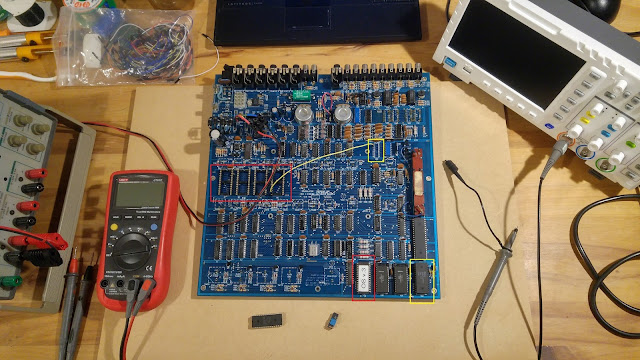Several months ago, I started building an MSX compatible computer board. This is Sergey Kiselev's OMEGA project :
I have no complaints about this project. Apart from the difficulty of supplying certain components and possible assembly errors, the computer works as soon as it is switched on.
I have already had the opportunity to discuss the cost of producing such a project. This is why I did not realized the keyboard proposed in this project, but rather a USB adapter allowing the use of a standard keyboard at low cost.
In order to put this computer into real operation, I therefore obtained a CARNIVORE 2 cartridge which provides, among other things, access to a storage medium in the form of a FLASH card:
And now is the time for things to get complicated!
At first, I tried to run the cartridge with a flash card that I had. Despite my best efforts, and although the cartridge menus were displayed, the flash card was never taken into account. So I ended up looking for a possible compatibility problem with my flash card. The flash card that I have and that works on my PC :
So I began to suspect the operation of the CARNIVORE cartridge. The first approach is to redo the welds. In order not to damage anything, I therefore used a hot air iron. I am used to work with this type of material so no problem. The result was the inability to start the cartridge itself.
So this time I visually inspected the cartridge and this is what I discovered:
From what I have been able to observe, it seems obvious to me that under these conditions the access to the memories of the cartridge, and therefore to the program in ROM seems highly compromised.
This is the original placement of the component. I absolutely did not touch the legs of the FPGA. The fact that the cartridge started when I got it seems have been a miracle. In the current situation, it is not possible to properly realign the pins of the FPGA. The only solution would be to remove this component and replace it with an FPGA with the pins correctly aligned. This problem only exists on one of the four sides of the component.
Well, the Cyclone II series FPGAs are no longer manufactured. And moreover it seems very difficult today to obtain such circuits!
Which brings me, after having worked for several months on this MSX board, to the following thoughts:
- Personal creations always come up against the problem of the case. Which one for OMEGA?
- Two cartridge ports, at the time it was probably perfect, but today?
- Operating mode selection by pressing specific keys at start-up: boring and outdated!
- C-bios is not a system. It just offers the minimum API to run some cartridges.
- Difficulty finding a version of the system corresponding to the needs.
- Slowness of this type of machine. More efficient solutions are possible ...
- Video resolution is really minimal ...
- Lack of structured, up-to-date and relevant documentation...
- Use of bad technical solutions for some realization. In the case of CARNIVORE, fpga, resistance adaptations to voltage differences etc...
- Etc...
While this type of machine could, if updated, provide real pleasures of use and programming, it is clear that entering the MSX world from scratch is not a trivial task. And yet, this type of machine can provide real development potential but still requires a flattening of the concept I think.
Don't make me say what I didn't say: making an OMEGA board and even starting it is a real pleasure. So far I haven't managed to start any application, and that's really annoying.
But hey, that makes it possible to think of modifications allowing to improve the situation ...

















